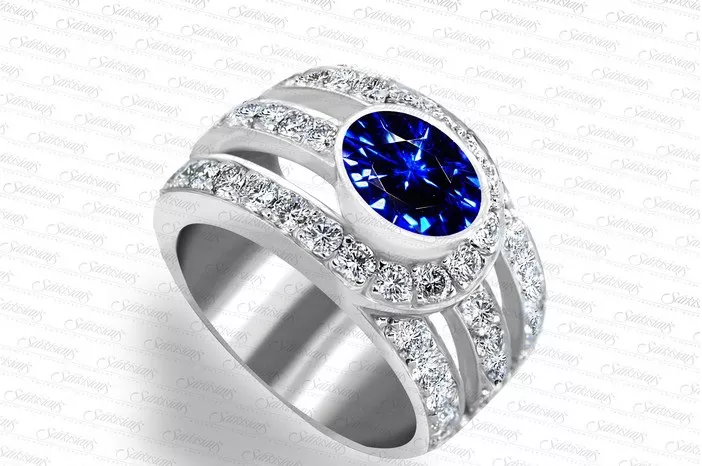Purple sapphires are captivating gemstones, admired for their unique and vibrant hues. However, with their popularity comes the risk of encountering imitations and synthetics. Identifying a genuine purple sapphire requires a keen eye and some knowledge of gemological principles. This article will guide you through the steps to distinguish a real purple sapphire from a fake, ensuring that your gemstone investment is both authentic and valuable.
Understanding Purple Sapphires
What is a Purple Sapphire?
Purple sapphires are a variety of corundum, a mineral that also includes other sapphires and rubies. The purple color in these sapphires is caused by trace elements like vanadium and chromium within the crystal structure. These gemstones are cherished for their rich, royal hues that can range from light lavender to deep violet.
Natural vs. Synthetic Sapphires
Natural purple sapphires are formed over millions of years under specific geological conditions. On the other hand, synthetic sapphires are created in laboratories and can mimic the properties of natural stones. While synthetic sapphires can be visually appealing, they do not hold the same value as natural ones.
Key Characteristics of Genuine Purple Sapphires
Color and Clarity
The color of a genuine purple sapphire should be vivid and consistent. Natural variations may occur, but these should be subtle. A real purple sapphire typically exhibits a rich, even color without any brown or gray undertones.
In terms of clarity, natural sapphires often contain inclusions, which are tiny imperfections or mineral traces within the stone. These inclusions can be an indicator of authenticity, as completely flawless sapphires are rare in nature.
Hardness and Durability
Sapphires rank 9 on the Mohs scale of hardness, making them extremely durable and resistant to scratching. This is second only to diamonds, which rank 10 on the scale. A genuine sapphire should be able to withstand everyday wear without showing signs of damage.
Methods to Identify a Real Purple Sapphire
Visual Inspection
Color Uniformity: Check the sapphire under various lighting conditions. A natural purple sapphire should display consistent color throughout. Be wary of stones with color zoning or patches of different hues.
Inclusions: Use a magnifying glass or a jeweler’s loupe (10x magnification) to inspect the stone for inclusions. Natural inclusions, such as needle-like rutile inclusions (silk), are common in real sapphires. Synthetic stones often have gas bubbles or curved growth lines.
Cut and Shape: Examine the cut and symmetry of the gemstone. While natural sapphires can be cut in various shapes, the precision of the cut can also indicate quality. High-quality stones are typically well-cut to enhance their brilliance.
Professional Testing
Gemological Certification: The most reliable way to ensure the authenticity of a purple sapphire is through a gemological certification from a reputable lab, such as GIA (Gemological Institute of America) or AGS (American Gem Society). These certificates provide detailed information about the stone’s origin, treatments, and quality.
Refractive Index (RI) Test: Sapphires have a distinct refractive index ranging from 1.76 to 1.77. A gemologist can perform an RI test using a refractometer to verify if the stone falls within this range.
Spectroscope Analysis: This test analyzes the light spectrum absorbed by the gemstone. Sapphires have a unique absorption spectrum, and a spectroscope can reveal if the stone exhibits the characteristic lines of a real sapphire.
UV Light Test: Exposing the sapphire to ultraviolet (UV) light can help determine its authenticity. Natural sapphires may fluoresce under UV light, although this is not a definitive test. However, it can provide additional clues when combined with other tests.
Common Treatments and Enhancements
Heat Treatment
Most sapphires on the market, including purple sapphires, undergo heat treatment to enhance their color and clarity. This process is generally accepted in the industry and should be disclosed by the seller. Heat-treated sapphires are still considered genuine but may be valued differently than untreated stones.
Diffusion Treatment
This treatment involves adding elements like beryllium to the sapphire to change its color. Diffusion-treated sapphires often have color that is only skin-deep and may not be permanent. These treatments should also be disclosed by the seller.
Synthetic and Imitation Stones
Synthetic Sapphires: Created in labs, synthetic sapphires can be identical in chemical composition to natural sapphires. However, they lack the rarity and value of natural stones. Look for curved growth lines and other indicators mentioned earlier.
Imitation Stones: Materials like glass, cubic zirconia, or colored quartz can be used to imitate purple sapphires. These imitations are usually softer and can be scratched more easily compared to real sapphires.
See Also: Yellow Star Sapphire vs. Blue Star Sapphire
Purchasing Tips
Reputable Dealers
Buy from reputable dealers who provide detailed information and certificates for their gemstones. Established jewelers are more likely to offer genuine stones and disclose any treatments or enhancements.
Return Policy
Ensure that the seller has a clear return policy. This provides an additional layer of security, allowing you to return the stone if it does not meet your expectations or if you discover it is not genuine.
Documentation
Request all relevant documentation, including gemological certificates and any details about treatments. This paperwork is essential for verifying the authenticity and value of the gemstone.
Trust Your Instincts
If a deal seems too good to be true, it probably is. High-quality purple sapphires come with a price, reflecting their rarity and desirability. Be cautious of significantly underpriced stones.
Conclusion
Determining the authenticity of a purple sapphire involves a combination of visual inspection, professional testing, and purchasing from reputable sources. By understanding the characteristics of genuine sapphires and using the right methods to evaluate them, you can confidently identify and invest in a real purple sapphire. Remember that while synthetic and imitation stones can be attractive, they do not hold the same value or prestige as natural, untreated purple sapphires. Always seek professional advice when in doubt, and enjoy the beauty and elegance that a genuine purple sapphire brings.


